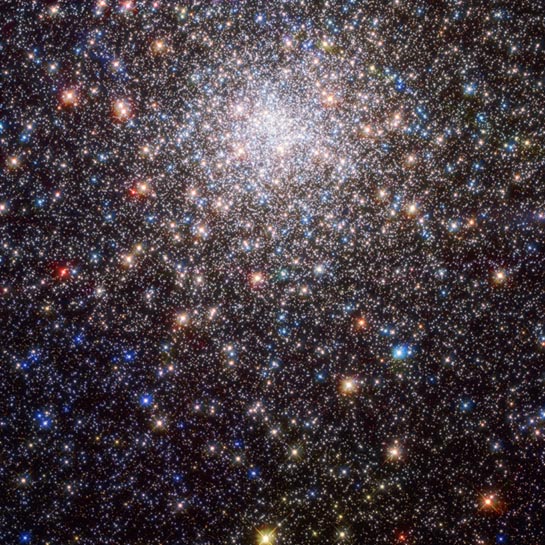
Globular Star cluster
RA 18h 24m 35.12s Dec -24° 52' 37.46"
Sagittarius
18,000 light years
7.66
13.8 arcmin
2.71 x 2.64 arcminutes
North is 49.3° left of vertical
ESA/Hubble & NASA, J. E. Grindlay et al.
March 11, 2019
ABOUT THIS IMAGE:
This Hubble image shows Messier 28, a globular cluster in the constellation of Sagittarius (The Archer), in jewel-bright detail. It is about 18,000 light-years away from Earth.
As its name suggests, this cluster belongs to the Messier catalogue of objects - however, when astronomer Charles Messier first added Messier 28 to his list in 1764, he catalogued it incorrectly, referring to it as a "[round] nebula containing no star". While today we know nebulae to be vast, often glowing clouds of interstellar dust and ionized gases, until the early twentieth century a nebula represented any astronomical object that was not clearly localized and isolated. Any unidentified hazy light source could be called a nebula. In fact, all 110 of the astronomical objects identified by Messier were combined under the title of the Catalogue of Nebulae and Star Clusters. He classified many objects as diverse as star clusters and supernova remnants as nebulae. This includes Messier 28, pictured here - which, ironically, is actually a star cluster.
Messier's mistake is understandable. While Messier 28 is easily recognizable as a globular stellar cluster in this image, it is far less recognizable from Earth. Even with binoculars it is only visible very faintly, as the distorting effects of the Earth's atmosphere reduce this luminous ancient cluster to a barely visible smudge in the sky. One would need larger telescopes to resolve single stars in Messier 28. Fortunately, from space Hubble allows Messier 28 to be seen in all its beauty - far more than a faint, shapeless, nebulous cloud.
From Wikipedia:
Messier 28 or M28, also known as NGC 6626, is a globular cluster of stars in the constellation Sagittarius. It was discovered by French astronomer Charles Messier on July 27, 1764. He briefly described it as a "nebula containing no star... round, seen with difficulty in 3½-foot telescope; Diam 2'." The 2' at the end indicates an angle of two arcminutes.
In the sky it is less than a degree to the northwest of the 3rd magnitude star Kaus Borealis. This cluster is faintly visible as a hazy patch with a pair of binoculars and can be readily found in a small telescope with a 8 cm (3.1 in) aperture, showing as a nebulous feature spanning 11.2 arcminutes. At 15 cm (5.9 in), the core becomes visible and a few individual stars can be resolved along the periphery. Larger telescopes will provide greater resolution, with a 25 cm (9.8 in) telescope revealing a 2' core.
M28
is at a distance of about 17,900 light-years away from Earth. It has a
combined 551,000 times the mass of the Sun and is 12 billion years old.
18 RR Lyrae type variable stars have been observed in this cluster. In
1986, M28 became the first globular cluster where a millisecond pulsar,
PSR B1821-24, was discovered with the Lovell Telescope at Jodrell Bank
Observatory. A total of 11 additional millisecond pulsars have since been
detected in the cluster with the Green Bank Telescope. As of 2011, this
is the third largest known population of pulsars in a cluster following
Terzan 5 and 47 Tucanae.